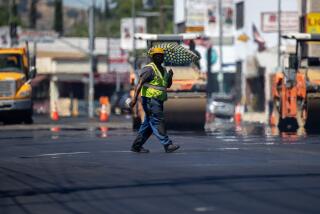School Condom Programs Backed : Poll: A longer calendar and year-round operation of campuses also gain popularity, Gallup Organization says.
- Share via
A solid majority of Americans believe public schools should distribute condoms, and such concepts as a longer school calendar and the year-round operation of campuses are gaining popularity, according to a nationwide poll released Thursday.
Respondents to the Gallup Organization’s survey of attitudes toward public education also said schools need improvement--and better financing--but doubted political leaders’ ability to bring about reform. The poll, commissioned annually by Phi Delta Kappa, a fraternity of educators, signaled some dramatic changes in the way Americans view schools.
The distribution of condoms, favored by 68% of respondents, “would have been unthinkable a decade ago,” pollsters said during a Washington news conference on the survey.
Of respondents who favored condom distribution, 43% said they should be available to all students who want them, while 25% said schools should require parental permission. Another 25% said the schools should not distribute condoms. Pollsters attributed the support for condom distribution to concern about AIDS and other sexually transmitted diseases.
Growing numbers of schools--including those in Los Angeles, New York City, Chicago and Portland, Ore.--are instituting condom distribution programs, often in the face of vociferous protests. The Los Angeles school district gives students access to condoms at a few selected high schools.
In conducting its 24th annual poll for the education fraternity, which is based in Bloomington, Ind., Gallup interviewed about 1,300 adults last spring. The margin of error is about 3 percentage points in either direction, pollsters said.
The survey also found growing support for a longer school year and more acceptance of school districts’ abandoning the traditional long summer vacation in favor of operating campuses throughout the year, with shorter, more frequent breaks.
A 210-day school calendar was favored over the current average 180-day year by a margin of 55% to 35%. Last year marked the first time the poll found that a majority--51%--wanted the longer year. Of those who supported a longer year in the 1992 survey, 59% preferred three-week vacations throughout the year over the traditional summer break.
Of special significance for riot-torn Los Angeles is a small section of the poll that dealt with race relations. About half of those surveyed said they believed that the nation’s schools were taking the necessary steps to promote racial and ethnic tolerance. But 71% called for more courses, counseling and activities aimed at promoting better understanding among students from different races and ethnic backgrounds.
Along with drugs, lack of adequate financing topped the list of problems facing public schools. Of those surveyed, 22% cited these two problems as the most pressing in their communities, while 17% cited lack of discipline; 9% cited fighting, violence or gangs, poor curriculum or standards, or large schools and overcrowding. Another 5% put difficulty in getting good teachers or lack of parental interest at the head of the list.
As in past surveys, people tended to believe that their communities’ schools were better than those across the nation; 40% gave their schools A or B ratings while only 18% gave the same high marks to public schools as a whole.
Some education reformers have blamed this phenomenon--a belief that “my schools are all right”--for impeding any widespread overhaul of the nation’s education system.
Americans favored some of the changes called for by the Bush Administration, including a system of national, standardized tests to measure achievement and an expansion of preschool programs for low-income youngsters. They also strongly favored using school campuses to provide health and social services.
But they exhibited little faith in the ability of George Bush--the self-styled “education President”--to bring about improvements in the schools. Only 15% gave the President a mark of A or B for his education reform efforts.
Governors fared somewhat better--19% of those surveyed gave them an A or B. For state legislators, the number giving the higher marks dropped to 14%. When it came to Congress, the marks were the lowest of all. Only 7% gave congressional education reform efforts an A or B, while 52% gave lawmakers Ds or Fs.
More to Read
Sign up for Essential California
The most important California stories and recommendations in your inbox every morning.
You may occasionally receive promotional content from the Los Angeles Times.














